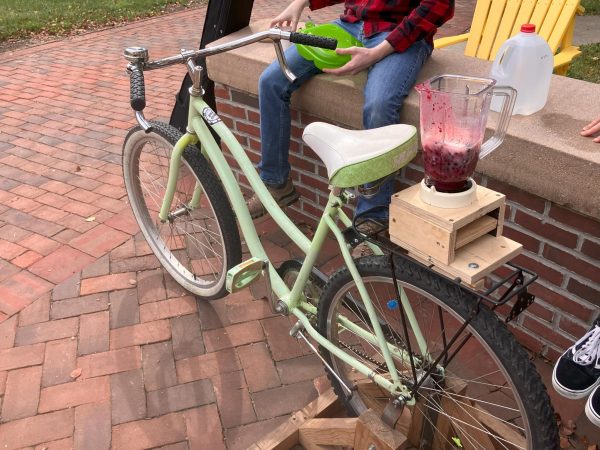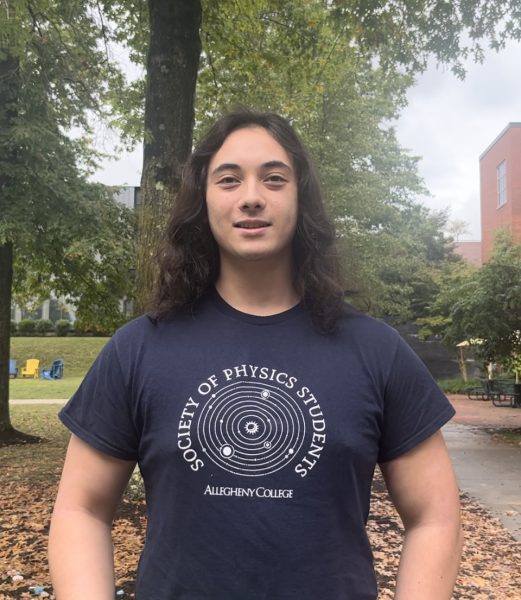Zingale Big Idea Competition welcomes more teams than previous years
At Allegheny College, the Zingale Big Idea competition is an open competition that emulates “Shark Tank” and gives students a chance to invent and defend different entrepreneurial ideas.
This year, the 11th annual competition was held and more judges than ever before travelled to Allegheny to judge both Allegheny teams and visiting teams from Grove City College.
The competition was started by Professor of Economics Chris Allison when he noticed other universities had started their own business competitions.
“I came to Allegheny to teach entrepreneurship and suggested to the department that [we] should have our own competition, and that’s how it got started,” Allison said. “It started out pretty small, and it’s pretty big right now.”
Co-coordinator for the Zingale Big Idea Competition and Quigley Hall Coordinator Sarah Holt said there are 20 teams competing this year with five from Grove City. The number of teams has increased to 20 from roughly seven proposals that were submitted during its first year, Allison said.
The competition is funded through a variety of sources, according to Allison. The first-place prize money, which has increased from $1000 to $5000 over 11 years, comes mostly from the competition’s namesake, Lance Zingale, ’77, who wanted to create more enthusiasm, Allison said.
“It’s funded through a variety,” Allison said. “We have a foundation in Cleveland who funds it. Mr. Lance Zingale made a big commitment to the college, and I fund it. But mostly it’s Mr. Zingale. That’s why we’ve named the competition after his family. He’s been a judge for a long time, he’s very engaged. He made this decision last year. He made a half a million-dollar cash commitment to the college.”
A majority of the judges are Allegheny alumni, but since competing students are from both Grove City and Allegheny, the judges are not told who attends Allegheny and who does not, according to Allison. The judges are chosen based on their careers, as most are either entrepreneurs or are involved and interested in entrepreneurship, Allison said.
Holt has been working with the competition for two years and is in charge of organizing the judges.
“I help Chris coordinate it,” Holt said. “He’s kind of the idea guy, and I worked in admissions for 15 years, so I did all their programs, so I bring all that expertise to this event.”
Holt said she is in charge of communicating with the judges, who come to Allegheny from across the country. The panel of 14 judges is an increase from the eight judges who came to Allegheny last year for the competition, according to Holt.
This year, Liana Leja, ’17, returned to Allegheny as a judge after winning the 2017 Zingale Big Idea Competition.
“I’m very excited to be on the other side this year and be a judge,” Leja said. “With my experience last year, it was a very challenging process but very rewarding in the end. I’m expecting the business ideas to be amped up even more this year … What I’ve gained from this one project has been crazy. It completely changed my career path, and I’ve received multiple opportunities because of this one project. I’m excited to know that’s what’s going to happen for these students as well.”
While Leja experienced her first time with the Zingale Big Idea Competition as a judge, Elise Brownell, ’75, visited Allegheny for her third year judging.
“I look forward with great relish to not only hear about the innovative ideas and very impressive presentations, but I enjoy the fact that for the first year this is different because the judges have the opportunity to see the rough cuts,” Brownell said. “I just love to be part of the process of applying what my experience has been and suggest changes.”
Along with the increased number of judges, another change that came to the Zingale Big Idea Competition this year was the number of tracks in which students explained their ideas, according to Holt.
“Last year, we had two different tracks because we had to squeeze everyone in in a day,” Holt said. “This year, we have three tracks because we pretty much have double the number of judges … which is exciting and it’s very helpful because now we’ll have three rooms, three tracks, where we’ll have teams be judged in front of three separate groups for the preliminary round.”
After the preliminary and final rounds of the competition, students, competitors and judges gathered in Quigley Hall to hear the winners on Saturday, April 28. Since the competition is named after Zingale and his family, Zingale announced the winners.
“This is just your first step in life, and you’re going to move forward and do bigger and better things and use this as your means for a launching pad,” Zingale said. “That’s what you’re going to get out of it. I was very impressed. Every year, the quality of competitors and what they do gets better and getter, and that’s really the purpose behind this …”
Introducing a new award this year to incentivize the recipient to continue working with his or her project, Zingale gave the Next Big Idea award, which was given $1000, to Aid Memoir, a project by Natalia Buczek, ’19.
Recipients of the honorable mention awards, which were given $500 each, were Chute and SEO Vineyard, two teams from Grove City. Chute was created by Steven Weaver, Levi Roberts and Boyce Cubarney, and SEO Vineyard was created by Connor Grieb.
Third place, which received $1500, was KnowIt, a project by Jeremy Moore, ’19, Eduardo Anaya, ’18, and Kadeem LaFargue, ’19. Second place, which received $2500, was munchYum, a project by Frank Chen, ’18, and Chris Miller, ’19.
First place, which received $5000, was Coin Capital, a project by James Burnette, ’19, Joe Nagel, ’19, and Austin Bristol, ’19. Coin capital is “a niche hedge fund that specializes in arbitrage trading with cryptocurrencies,” according to Nagel. The team came up with the idea when they looked into different ways to profit from large price gaps in cryptocurrency markets, Nagel said.
The Coin Capital team has been working on the idea since last December and has been creating a successful algorithm to trade and generate profit in such markets, Nagel said.





